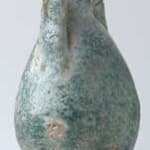Parthian Faience Two-Handled Vessel, 100 BCE - 3 CE
Faience
6.5
PF.3830
Further images
After the death of Alexander the Great, his expansive empire was divided among three of his most loyal generals, with Seleucis assuming control of the eastern portion. The Seleucid Dynasty...
After the death of Alexander the Great, his expansive empire was divided among three of his most loyal generals, with Seleucis assuming control of the eastern portion. The Seleucid Dynasty was thereby established, following in the footsteps of the Persian, Assyrian, and Babylonian Empires, with its capitals at Antioch (in modern Syria) and Seleucia (in modern Iraq). However, as history has shown, maintaining calm and order over such a large territory, encompassing so many different cultures, proved difficult if not impossible. In 245 B.C., the Parthians revolted against the Seleucids under the leadership of Satrap Andragoras, igniting a civil war that would lead to further autonomy, despite the continued recognition of the Greek kings as their superiors. Although the Parthians had been mentioned in Assyrian text as early as the 7th Century B.C., it was not until the rise of Mithradates I that the yoke of Seleucid control was toss aside and Parthia reached the heights of its glory. Mithradates the Great quickly conquered the lands of Babylon, Media, and Elam, establishing a great empire that would rival Roman dominance and last until 224 A.D. when the Sassanid Empire finally subjugated their lands.
Resting on a short base, the bulbous body flares outward to the middle then narrows gradually to the neck. Attached by two handles the neck rises vertically to an everted lip. The handles are rather thick, spreading wide at the top then curving downwards to flow with the form of the vessel's body. The handsome blue color still retains its luminosity, made even more vivid in contrast with the encrusted areas. This vessel probably contained oil, or some liquid used in votive offerings.
Resting on a short base, the bulbous body flares outward to the middle then narrows gradually to the neck. Attached by two handles the neck rises vertically to an everted lip. The handles are rather thick, spreading wide at the top then curving downwards to flow with the form of the vessel's body. The handsome blue color still retains its luminosity, made even more vivid in contrast with the encrusted areas. This vessel probably contained oil, or some liquid used in votive offerings.
32
of
32









